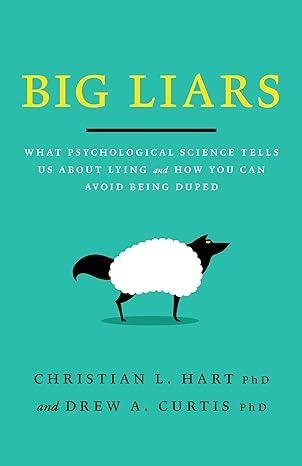Big Liars: What Psychological Science Tells Us About Lying and How You Can Avoid Being Duped
Lying is a pervasive aspect of human interaction, affecting personal relationships, professional settings, and even global politics. Understanding the psychological mechanisms behind lying and learning how to identify deceit are essential skills in navigating the complex social world. "Big Liars: What Psychological Science Tells Us About Lying and How You Can Avoid Being Duped," part of the APA LifeTools Series, provides a comprehensive exploration of these topics. This article delves into the book’s key insights and practical advice to help readers become more discerning and less susceptible to deception.
The Psychology of Lying
Lying is a multifaceted behavior that can be driven by various motives, including self-preservation, avoidance of punishment, and manipulation for personal gain. The book outlines several psychological theories that explain why people lie:
- Cognitive Load Theory: Lying requires more mental effort than telling the truth. When someone lies, they need to create a story, remember the details, and maintain consistency, which increases cognitive load. This increased effort can lead to detectable signs of deceit, such as longer response times and more speech hesitations.
- Self-Regulation Failure: People often lie when their ability to self-regulate is compromised. Factors like stress, fatigue, and emotional distress can reduce a person's capacity to maintain honesty. Understanding this can help individuals recognize when they are most vulnerable to being lied to.
- Social and Cultural Factors: Lying is influenced by social and cultural contexts. For example, some cultures may view certain types of deception as more acceptable than others. The book highlights how understanding these nuances can help in detecting lies across different social settings.
Types of Lies
Not all lies are created equal. The book categorizes lies into several types, each with distinct characteristics and detection strategies:
- White Lies: These are minor lies told to avoid hurting someone's feelings or to smooth social interactions. Although often considered harmless, understanding the prevalence of white lies can help in assessing the honesty of more significant statements.
- Exaggerations: These lies involve overstating facts or accomplishments. Detecting exaggerations requires careful attention to the consistency of details and a comparison with known facts.
- Fabrications: These are entirely false statements created to deceive. Spotting fabrications often involves cross-referencing information and looking for inconsistencies in the liar's story.
- Omissions: These lies occur when critical information is deliberately left out. Recognizing omissions involves asking probing questions and being aware of what is not being said.
Detecting Deception
The book provides practical strategies for identifying lies, drawing from psychological research and expert insights:
- Behavioral Cues: Certain nonverbal behaviors can indicate deceit. These include avoiding eye contact, increased blinking, fidgeting, and changes in vocal pitch. However, the book cautions that these cues are not foolproof and should be considered alongside other evidence.
- Verbal Cues: Lies often reveal themselves through verbal inconsistencies. Liars may provide overly detailed stories, contradict themselves, or exhibit changes in their speech patterns. Listening carefully to the structure and content of what is said can reveal hidden deceptions.
- Contextual Analysis: Understanding the context in which a statement is made can provide clues to its veracity. This includes considering the liar's motives, the plausibility of their story, and the consistency of their behavior over time.
- Scientific Tools: Advances in technology have provided new tools for detecting lies. Polygraphs, voice stress analysis, and even neuroimaging techniques are discussed in the book. While these methods are not foolproof, they can provide additional layers of scrutiny.
Avoiding Deception
Preventing oneself from being duped involves not only detecting lies but also fostering environments that promote honesty:
- Building Trust: Encouraging open communication and trust within relationships can reduce the likelihood of deceit. The book emphasizes the importance of creating safe spaces where honesty is valued and rewarded.
- Critical Thinking: Developing a habit of critical thinking and skepticism can help individuals assess the truthfulness of statements. This involves questioning the source of information, considering alternative explanations, and seeking corroborative evidence.
- Emotional Intelligence: Understanding and managing one's emotions can reduce susceptibility to deception. Emotional intelligence helps in recognizing manipulative tactics and maintaining composure when confronted with potential lies.
- Education and Awareness: Increasing awareness about the prevalence and mechanics of lying can empower individuals to better navigate their social worlds. The book advocates for educational programs that teach lie detection skills and promote ethical communication.
Conclusion
"Big Liars: What Psychological Science Tells Us About Lying and How You Can Avoid Being Duped" offers a thorough examination of lying from a psychological perspective. By understanding the motivations behind deceit, recognizing different types of lies, and employing practical detection strategies, readers can become more adept at navigating a world where deception is a constant threat. The book not only equips individuals with tools to detect lies but also promotes a culture of honesty and integrity, essential for healthy personal and professional relationships. Whether dealing with minor social fibs or major manipulations, the insights from this book are invaluable for anyone looking to protect themselves from deception and foster more truthful interactions.
